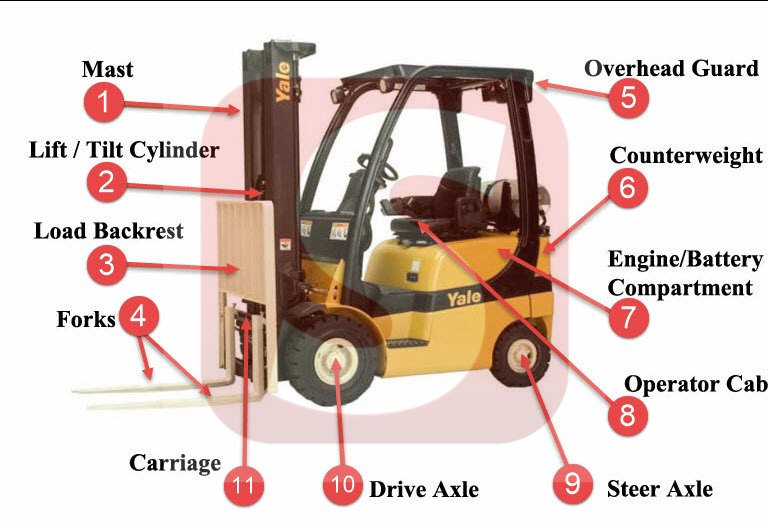Our Products:
Contact Sourcefy:
Address:#108-209 Glen Cove Rd
Carle Place, NY
United States 11514
Email: support@sourcefy.com
Toll-free: 1-855-585-4430
Map
Articles
Structure of the Forklift
Posted on
Hello, today we are going to show you the structure of the forklift:

1.) The Mast is the vertical assembly that does the work of raising, tilting and lowering the load. It is driven hydraulically, and operated by one or more hydraulic cylinders directly or using chains from the cylinder or cylinders. The mast supports the carriage that allows its vertical movement with the hydraulic lift.
2.) Tilt cylinders pivot the mast forward or backward to assist in engaging a load, and hydraulic cylinders are mounted to the truck frame and mast. Hydraulic cylinder is a mechanical actuator that is used to give a unidirectional force through a unidirectional stroke.
3.) Load Backrest is a rack-like extension that is either bolted or welded to the carriage in order to prevent the load from shifting backward when the carriage is lifted to full height.
4.) The Forks are two cantilevered arms that carry the load.
5.) Overhead Guard is a metal roof supported by posts at each corner of the cab. It is providing overhead protection for the operator from falling objects.
6.) Counterweight
is a mass attached to the rear of the forklift truck frame. That is the weight
installed by the manufacturer and its purpose is to give stability to the
machine under load.
7.) Engine/Battery Compartment may consist of an internal combustion engine that can be powered by LP, gas, CNG, gasoline, or diesel fuel. Electric forklifts are powered by either a battery or fuel cells that provide power to the electric motors.
8.) Cab is the area that contains a seat for the operator along with the control pedals, steering wheel, levers, switches, and operator readouts. The cabs are designed to meet safety during operation, protect the truck operator from the adverse effects of the external environment and meet the requirements of ease of use and reliability.
9.) Steer Axle is a central shaft that rotates a wheel or a gear. The axle also absorbs the forces of acceleration and braking and transfers them away from the wheels.
10.) Drive Axle is the piece of equipment which is elastically fastened to the framework of the vehicle with a lift mast. The lift mast affixes to the drive axle and can be inclined, by no less than one tilting cylinder, around the drive axle’s axial centerline.
11.) Carriage is a support structure where the forks are attached or mounted. Like the mast, the carriage may have either rollers or bushings to guide it in the interlocking mast rails.
 Loading... Please wait...
Loading... Please wait...


